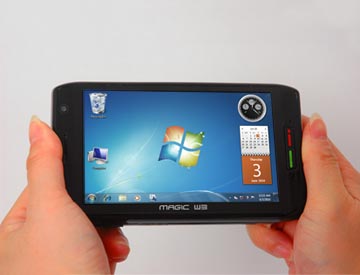
Posted on 22 July 2011

Excitement turned to disapointment yesterday when I took a closer look at this 4.8″ UMPC. The Magic W3.
No it wasn’t the 800*480 screen that disapointed me the most although Windows 7 on that resolution is not recommended by Microsoft. It wasn’t the small battery which would probably only return 2.5hrs in-use battery life and it wasn’t the fact that it’s aiming for a highly niche phone-pc market (read expensive.)
The most disappointing thing about the Magic W3 is that it uses the ‘old’ Menlow platform. Oaktrail technology (that’s the Z6xx series of Atom CPUs) has been sampling for well over a year now and given the clear advantages of Oaktrail in a device like this it’s hugely disappointing to see Menlow. Maybe the price was too high or, more likely, this has been developed over more than a year by a small firm that doesn’t have access to the samples that the big guys do. Intels partner teams should be reaching out to manufacturers like this and helping get their best silicon inside.
Just think about what’s being missed here.
Smaller form factor platform
Lower tdp
2x graphics speed
Hardware video encoder
Faster memory bus
Faster disk I/o
Vastly improved standby times
Longer in-use battery life
New power states
Windows 8 forward advantages
Intel Meego and Android builds which could bring even better battery life.
That’s a list of advantages I would not ignore if I was developing a ultra mobile PC product today.
I’m trying to find out availability, price but at this stage, I’m not expecting this to be appearing in too many retailers books. Specialists only? What do you think? Will it even reach the market?
In the next article today I’ll be looking at the Fujitsu F 07 C, a ultra mobile PC with a 4″ screen that is built on Oaktrail.
http://www.advancetc.com/index.htm
Posted, possibly while reclining, with the Galaxy Tab 7
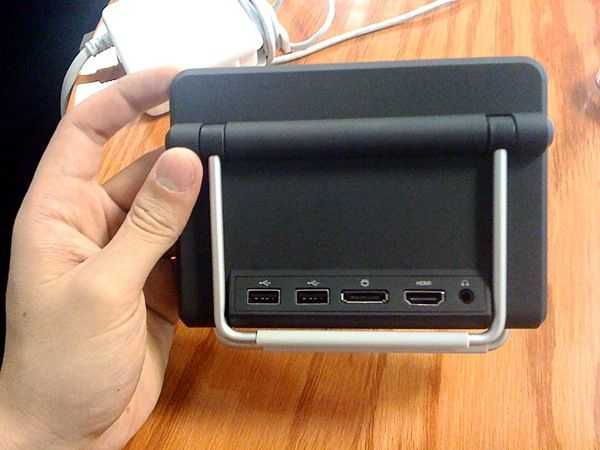
Posted on 20 April 2010
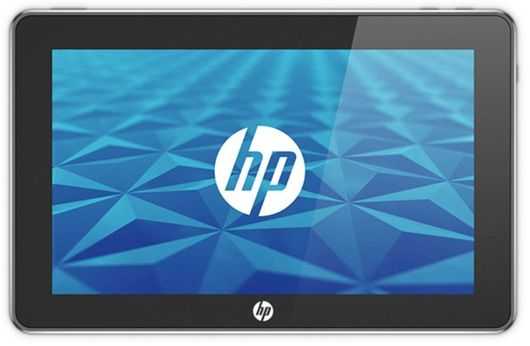
Yes, I’m calling this a UMPC. Why? Because it is! It has closer ties to everything that we’ve done over the past four years on UMPCPortal than any social and entertainment ARM-based ‘pad.’ It’s built with ultra mobile PC components (Z530 as used in nearly all Windows-based Ultra-Mobile PC’s ) and it runs Windows 7. I won’t be subscribing to the iPad comparisons just because it’s got an 8.9 inch screen; that would be too simple and would miss the point. As for it being a ‘netbook without a keyboard’ well, it’s closer but still somewhat misleading.
Update: HP Slate information, comparison, specs and links now in the database
The HP Slate looks like it could be one of the best mobile tablet PCs we’ve seen for a long time (could it top my personal favorite, the X70?) and I’ll be working to get some review-time with it as soon as possible but I know already that it won’t impress anyone looking for a slick consumer-centric device. It’s questionable that a 1.6Ghz Menlow will provide enough power to drive Windows 7 satisfactorily too but having done lots of testing with my Viliv S10 multitouch convertible, based on exactly the same hardware and software, I can tell you it works quite well, as long as the SSD is fast. Again, not slick, just productive.
Here’s the latest hands-on article but unfortunately, they take the iPad route. They also assume that it has a broadcom chipset like everyone else; forgetting that the Poulsbo chipset that pairs with the Z530 already has an integrated HD video decoder.
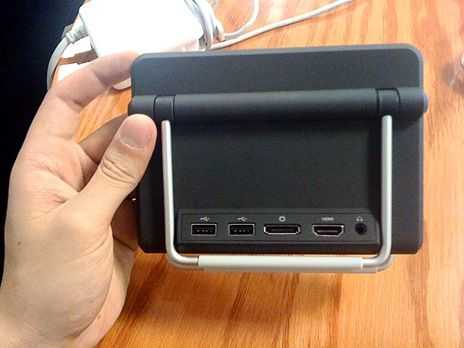
They do manage to uncover a docking station though and that’s a very useful addition, especially if it’s included in standard retail package. [He says, using a U820+docking station to write this article.]
More photos at the source: Conecti.ca
Via netbooknews.de

Posted on 13 January 2009

What do you do when the Dell Mini 9 [Product page] and Mini 12 just aren’t enough? Well the only logical thing to do is come out with the Mini 10. The Dell Mini 10, shown at CES, has (obviously enough) a 10″ screen. Something that immediately piques my interested is that the Mini 10 apparently won’t run the obligatory 1024×600 resolution, but instead use a properly formatted 16:9 aspect ratio screen with a 720p resolution (1280×720). Some other nice features include:
- Z530 Atom CPU (less typical than most netbooks)
- 802.11N WiFi
- Integrated GPS
- Integrated 3G
- TV-tuner
- A trackpad with what Dell is calling “exclusive gestures”
I have to say that this is shaping up to be a nice 10″ netbook. We’ll see how the pricing turns out, which at this point is not announced by Dell, nor a release date.
[Engadget]
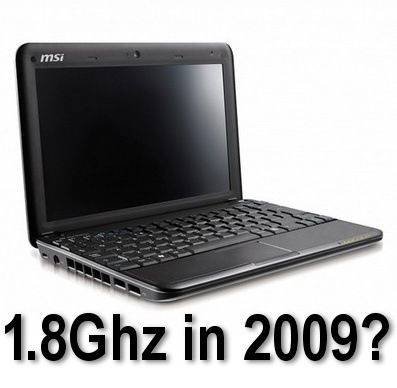
Posted on 10 December 2008
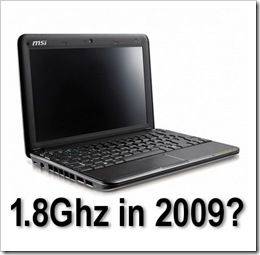 Ben reported on the new MSI netbooks recently [Not your standard cookie-cutter specs] and highlighted that MSI will use the Z530 and Poulsbo chipset, the Menlow platform, originally designed for MIDs, and not the existing netbook platform. They aren’t the first netbook devices we’ve heard about that will use this platform as the Dell Mini 12 is already out there using it but it could be that we see a lot more of these as it offers an interesting marketing possibility at a time when netbook manufacturers are trying to make their products stand out from the crowd.
Ben reported on the new MSI netbooks recently [Not your standard cookie-cutter specs] and highlighted that MSI will use the Z530 and Poulsbo chipset, the Menlow platform, originally designed for MIDs, and not the existing netbook platform. They aren’t the first netbook devices we’ve heard about that will use this platform as the Dell Mini 12 is already out there using it but it could be that we see a lot more of these as it offers an interesting marketing possibility at a time when netbook manufacturers are trying to make their products stand out from the crowd.
LaptopMag recently interviewed MSI and asked about their decision to use the Menlow platform. The answer gives us some clues.
Why would MSI use Menlow? Part of the answer comes from MSI in the LaptopMag interview:
“Now we are going to come out with the U110 and the U115. These are similar to the past systems in size and will look like the original Wind but they utilize the Intel Atom “Menlow inch processor the Atom Z530.
The U110 and the U115 will be out in late January. The biggest difference between these two models is their battery life. With the U110, we will deliver 8 hours of computing time; and 10 hours with the U115. Both will use a 6-cell battery.”
So it looks like the 1.6Ghz Menlow platform is attractive because of battery life. Not surprising as it offers a lower idle power and lower in-use power. Battery life is a very important differentiator. Menlow’s hardware video decoding (1080p using H.264) can be used to differentiate too but here’s something that is more interesting and you probably won’t hear any product manager talk about it in these terms. The Menlow platform goes up to 1.8Ghz and CPU speed is about the best differentiator a marketing group could hope for. In netbook quantities, I wouldn’t expect any noticeable difference in the price either. $20 at the till maybe. When your average netbook customer is standing with a Saturday sales rep. in the local electronics store and has a choice between a a Samsung NC10 at 1.6Ghz and an MSI Wind at 1.8ghz, for the same price, which one is the customer more likely to go for?
If this process works, if sales figures indicate a preference for 1.8Ghz, expect either a clock boost on the N270 CPU (which is likely of course) or, for the higher-end of the netbook market and the ultra portable notebook market, a lot more action with Menlow in 2009. From where we are sitting, it looks like Menlow could eat into even more of the traditional laptop market but if it’s a net gain for Intel, they won’t complain!
Check out the interesting interview and watch out for comments about Linux, touchscreens and a temporary HDD set-up.

Posted on 29 November 2008
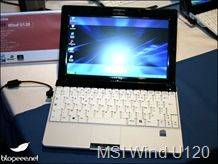 Finally a breath of fresh air in an area of computing where the only major difference in products was appearance and price!
Finally a breath of fresh air in an area of computing where the only major difference in products was appearance and price!
I’m really glad to see some interesting new stuff from MSI. We recently talked about the MSI Wind U120 [Portal page] which is just like the original U100 but with 3G and some increased storage options, but that isn’t very exciting is it?
Now news is spreading that MSI will be releasing two additional netbooks some time around January. The netbooks will be the U110 and U115; I’ve put the interesting things in bold:
- 1024×600 10" screen
- 1.6GHz Intel Atom Z530 CPU – which is a more expensive but less power hungry chip (2w) than the Atom N270 (2.5w) which is in almost every netbook you see today
- Poulsbo US15W chipset – most netbooks are using the Intel 945G. Poulsbo in combination with the Z530 CPU will make for a total chipset drain of 4.3w
- 6-cell battery
- Up to 250GB HDD for the U110
- Hybrid Storage – The U115 will feature SSD and HDD combinations. The idea is that the OS and programs can go on the smaller capacity SSD (8/16/32GB) for quick booting and program launching, then there will be plenty of room for media and other storage on the HDD (80/120/160GB). Computers such as the VAIO TZ have used a similar storage configuration. It will be important to the success of the U115 that this doesn’t consume too much power running both drives.
- Wi-Fi B/G/draft-N
- The rest is pretty common; Bluetooth, 1GB of RAM (up to 2GB on the U115), 3x USB 2.0 ports, 2.0MP webcam etc.
Like I said, all of this is new and exciting to see in a netbook. However, after reading this I can’t help but wonder how they plan on keeping the prices down. Nearly everything in this list will run the price up over current netbooks: new CPU+chipset, two storage drives, and draft-N Wi-Fi. We’ll have to wait and see but I would image the top end U115 will run you somewhere around $700 if not higher.
[Blogeee] via [Liliputing] [Electric Vagabond]





















